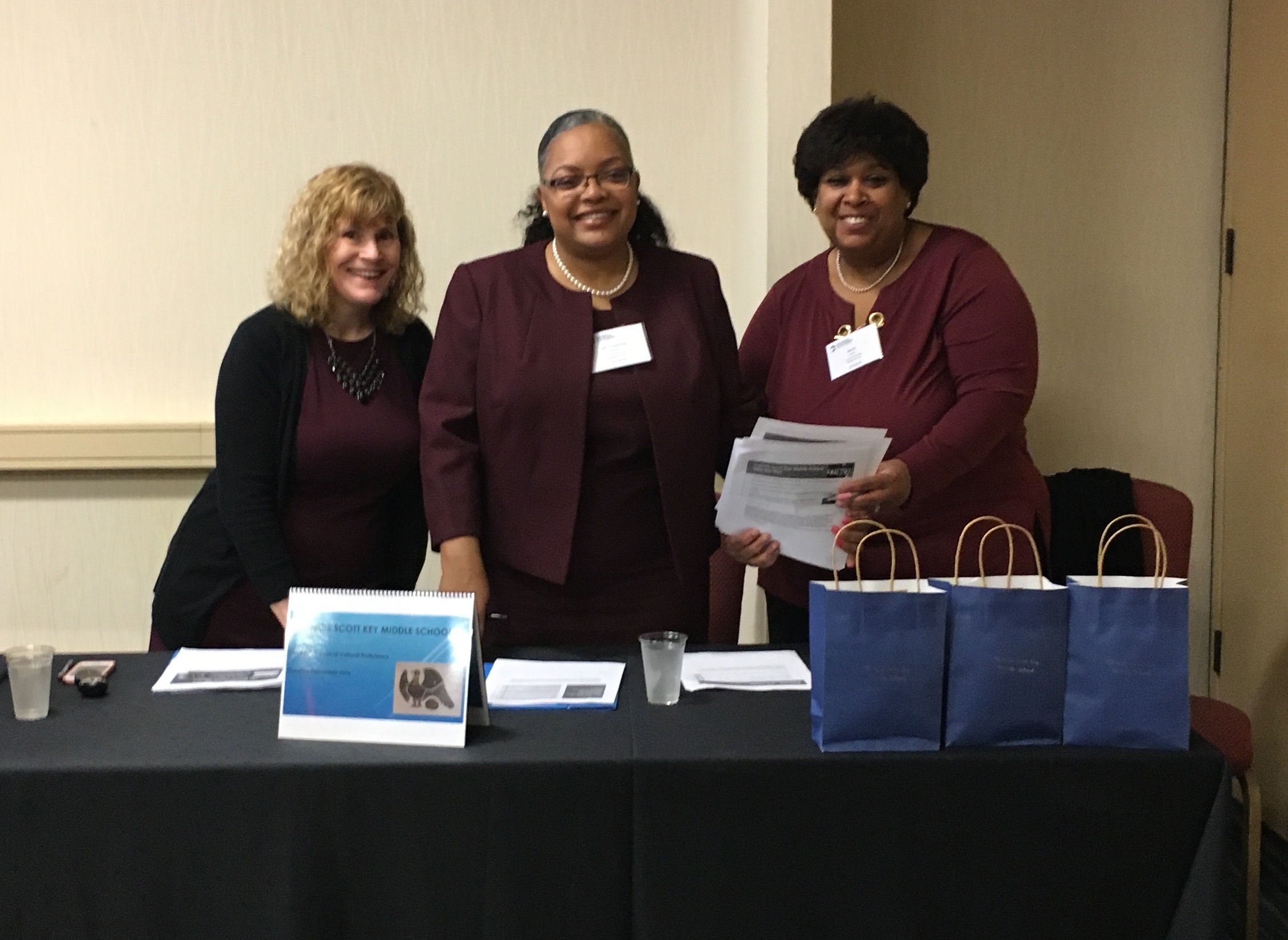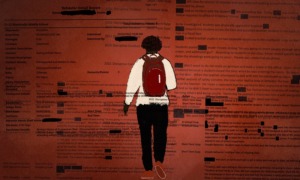“I want to be more productive in my community. I want to be a part of something bigger.”
—J.C.V., 14
It seems like a simple idea — listening to what students have to say. Schools do that all the time. What we learned was that our students were telling us something very important. They were sharing not only ideas like wanting to listen to music during lunch, needing less homework or wanting to eat snacks during class. When we really listened to their voices, and asked questions that dug deeper, we heard who our students really are — their hopes, their dreams, what will help them reach their goals and, most importantly, how they want to make a difference in the world.
As an International Baccalaureate World School Middle Years Programme (MYP), the core of our work is our mission statement. The primary focus of the school’s mission is to enable our students to “… gain confidence and competence as lifelong-learners who are college and career ready, open-minded, and responsible global citizens.” This ideal is in direct alignment with the International Baccalaureate mission to “… develop inquiring, knowledgeable and caring young people who help to create a more peaceful world through intercultural understanding and respect.” Our task as a school has become creating a community of students who have the capacity and will to be global activists.
On our journey toward building the cultural proficiency of the staff at our comprehensive middle school in a suburb 10 miles outside Washington, D.C., in Silver Spring, Maryland, we stumbled upon what has become the catalyst of our work. During the National Youth at Risk Conference in early March, we called it our “beacon.” What we found was our students’ voices.
“Many people stand up for many people’s rights. So, I can also stand up for people’s rights. I can also help people.”
—T.M.P., 12
Our path to developing a program to elevate student voice actually started with developing cultural proficiency with our staff. The foundation of the work with teachers was based on key concepts from Glenn Singleton’s book “Courageous Conversations about Race.” Through Singleton’s agreements for courageous conversations as well as the conditions he established, we worked to build staff understanding about who they are racially and culturally and to recognize that we need to understand the racial and cultural identity of each student.
During this time, teachers uncovered the path between cultural proficiency, culturally responsive teaching, high expectations and equitable classroom practices. It was our goal to help the professional learning community understand that culturally responsive teaching practices, equitable classroom strategies and high expectations are the way personal cultural proficiency is manifested. While our immediate goal with the professional development was to develop cultural proficiency for the staff, the ultimate goal was to help cultivate our students into becoming critically minded forces of change for themselves, their communities and the world.
While the staff was able to explain the concepts related to cultural proficiency as well as discuss the elements of Glenn Singleton’s work that had been our focus, they never really related any of these practices to our students. We made the connection, but now what? Did teachers really get how these strategies supported student learning?
When asked, “How does this help us to achieve our mission?” the response was, “They are good instructional practices.” We were complying, but were we committed? Teachers were using the equitable practices, but did they really see how important these strategies were in developing students into agents of change? This was the moment we knew that we had to pull out all the stops. Staff needed to hear student voices. They needed to know that our students have hopes, dreams and incredibly high expectations for themselves. We had to make the work personal.
“I want to be an agent of change for myself in the way that I’ll always look for a better path, and try to ask other people in my community to help me improve as a student and as a person overall.”
—A.J., 14
It became evident that the most relevant and impactful way for staff to learn about who the students are, beyond a name on a seating chart, was to hear from the students themselves. The Student Voice Project was born.
This project started with informal conversations with students and has slowly grown to the full-year project that it is today. The project now begins with students participating in focus group meetings. During the meetings teacher volunteers ask questions about how students want to make a difference in the world. Students are asked about the importance of education in reaching their goals, and they identify classroom strategies that they feel would best support them. Data is collected from these focus groups to identify classroom practices that students feel support them the most in achieving their goals.
Teachers facilitate a schoolwide lesson focused on developing skills students would need to share their voices positively and effectively. Connections are made between positive behavior expectations and how those expectations would impact the way others would “hear” a message. Students also participate in simulations, sharing their voice about a variety of situations in constructive ways.
“If you don’t share your voice, you’re not going to be heard. No one’s going to listen to what you have to say. And if you don’t share it, then you’re not setting people up for failure, you’re setting yourself up for failure.”
—S.S., 14
In working to make it personal for staff, providing authentic reasons for developing the knowledge and skills necessary to build cultural proficiency, a serendipitous thing happened. We began building a path for students to follow to make the difference in the world that they want to make. Students began to realize that making that difference means more than passive participation; it requires action, passion and voice.
As an International Baccalaureate Middle Years’ Programme school, there is an expectation that student participate in community service projects. Students take part in canned food drives, they donate money for charities and they walk to raise funds — all worthwhile projects that were organized and facilitated by adults in the school. Over the past year, however, other community service projects and activities were born, nurtured and blossomed — not through the work of staff, but through the voice of students.
- Student volunteers participated in a panel discussion at the Legislative Action Conference for the School Nutrition Association. Students offered suggestions about how to improve school breakfast and lunch programs. Students had to demonstrate critical thinking skills as well as their ability to communicate clearly and effectively as they discussed their ideas and answered questions that they had not previously encountered.
- The National Junior Honor Society identified two charities, the American Cancer Society and the Flint Water Fund/United Way of Genesee County, that they wanted to support. The students worked to develop and implement a fundraiser for the organizations by having students vote for teachers to complete dares by making donations for the organizations.
- A student panel participated in the College and Career Expo, presenting the benefits of MYP to students and parents of Montgomery County, Maryland. They also discussed what the program entailed in each grade level and shared how MYP prepared them to be college- and career-ready.
- Students volunteered to support the monthly Family Food Market. Students not only help set up for the event, they work to support families as they visit the market.
- The school Debate Club works with college mentors to learn the process and skills of debate.
- A grassroots group of sixth-grade girls worked on their own to run a fundraiser for the National Wildlife Federation. Not only did the students organize the entire fundraiser, they more than tripled their goal of $300 by collecting more than $1,000.
- Seventh-grade students arranged for a Community Clothing Drive, initiating and organizing the event on their own, collecting truckloads of donations.
“I want to get the homeless people homes that they can live in, and give them food so they can have a better life.”
—R.T., 12
Shifts in developing growth mindset is a journey. We have found that many staff members are still developing their cultural proficiency. We have, however, started the conversations necessary to move ahead with our journey toward building a community of global activists. We will continue to elevate our students’ voices knowing that their possibilities both as students and as agents of change are endless. Our students are the beacon for our professional work — improving our practices —
as they share their voices and illuminate the world.
“If we all gathered up and spoke as one with power, we can do anything.”
—N.Y., 13
Helen Webster is a staff development teacher for Montgomery County Public Schools in Maryland.
Yolanda Stanislaus is a middle school principal for Montgomery County Public Schools in Maryland.
Beth Hester is a Middle Years Programme coordinator for Montgomery County Public Schools in Maryland.

























